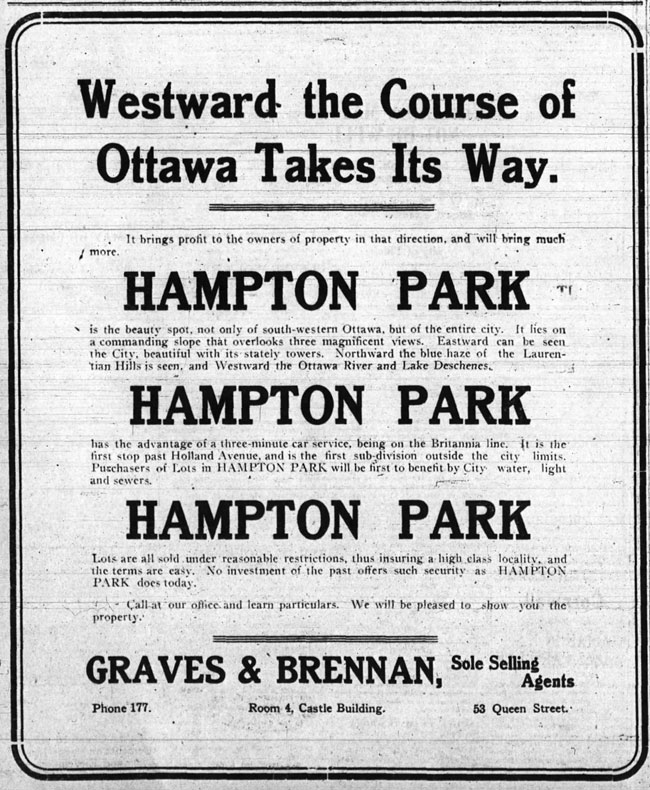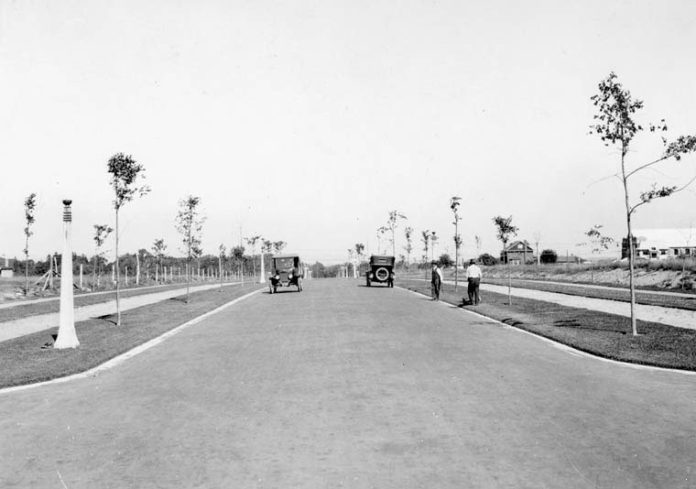Hampton Park is a popular, well-established and upscale neighbourhood and parkspace in Ottawa’s west end, which is exactly how subdivision founder John Charles Brennan envisioned it over 100 years ago.
Brennan, along with business associates Andrew Holland and William Scott, purchased the majority of what was the Cowley family farm in 1895. The land remained vacant as the surrounding area (Westboro to the west, and Hintonburg to the east) rapidly developed, largely through the arrival of streetcars, but Brennan was happy to sit on his investment and wait for an opportune time to develop.
Brennan had arrived in Bytown in his youth, working in – and eventually taking over – a well-known grocery store at Rideau and Sussex. He later turned to real estate, and was one of Ottawa’s most well-known and esteemed citizens, actively involved in many areas of social, political and church life.
By 1908, John had bought out Holland and Scott, and brought on his brother Herbert as a partner. In 1909, the brothers incorporated, naming their company Hampton Park Limited. “Hampton” was one of names they chose for their subdivision, deliberately titled after affluent districts of London, England, in order to create a sense of prestige and stature for the neighbourhood.
It is interesting that the brothers selected the name Hampton Park, since, at the time, their 147-acre property was little more than old farm land, approximately a third of which was covered in thick tree and bush. The Park consisted of Wellington south to Carling, between Mayfair on the east (then the border between Nepean Township and the City of Ottawa) and Kensington on the west (with the exception of the Convent property). Like most proprietors of the era, they gradually created small subdivisions to meet demand.
The first Hampton Park plan was filed in March of 1910, establishing the small section of Mayfair and Piccadilly Avenues, between Wellington and the streetcar line (now Byron). Nowadays this would be considered part of Wellington Village, but in fact this was the inaugural Hampton Park neighbourhood.
The first house in this area was constructed in late 1912 (421 Mayfair was built by Richard Bassett, for whom the adjoining street Bassett Lane is named). In mid-1912, the second HP plan laid out the property immediately south of the streetcar line, creating three new streets: Kensington, Windsor, and Brenmore, plus extending Piccadilly and Mayfair to Iona Street.
Lots were offered from $400 to $650, with 10% cash down payments. Advertisements placed during that time reveal Brennan’s objective to promote the community as a “high class” residential section. Ads also assured potential residents: “There will be no shacks on Hampton Park.”

In 1914, the first lots south of Byron were sold to builder, John Foster, who immediately constructed three houses (440 and 446 Kensington, as well as the original no. 436 which burned in 1943).
In 1916, the first baseball game was played at Hampton Park, when the “Ottawa West” team joined the Trolley Line Baseball League (featuring teams representing the small communities along the streetcar line to Britannia). The original diamond was located closer to Byron.
Notably, in 1921, the Ottawa Improvement Commission purchased a large portion of Hampton Park for the new Island Park Driveway. This was a bonanza for Brennan, as the somewhat nondescript property suddenly bordered the popular new driveway on both sides. It is no wonder Brennan sold the required land for just $1.
he Driveway opened in 1923, leading to increased demand, so in 1925, Brennan filed a third HP plan, laying out the streets south of Iona to the C.N.R. line (now the Queensway). Interestingly, the plan also included a plan of streets and blocks on the west side of Island Park, including such streets as Cambden, Wilmer, a relocated Brenmore Avenue and extensions of several streets from the east side.
Herbert Brennan passed away in 1918 and John in 1926. H. Clifford Brennan (Herbert’s son) took a lead role in the continuation of the family business.
In late 1927, the Federal District Commission (now the N.C.C.) purchased 42 acres of Hampton Park property for $40,000, for future development. It was this move that thankfully saved the park space which remains nearly 90 years later.
In 1928, the first house was built on Island Park north of the C.N.R. (now 605 Island Park Crescent); in 1930, the first house on the west side. 470 Island Park Drive, built by John R. Booth Jr., grandson of the Canadian lumber and railway baron; in the mid-1940s it was sold to the Mexican government to house its Ambassador.
In the 1930’s, the residents of Hampton Park lobbied for annexation to Ottawa on several occasions, but were refused by the OMB, due to the problems it would cause to Nepean Township’s finances. The suburb would have to wait until 1950, when a large part of Nepean was added to Ottawa.
By the late 30’s, the real estate market had slowed, and Hampton Park Ltd. sold off lots at bargain prices, before eventually surrendering many lots to the Township due to unpaid taxes. Between the depression and WWII, it was simply not viable to continue to pay property taxes on vast amounts of land which could not be sold, even at prices as low as $50 or $100 per lot. Home construction in this period was at a virtual standstill.
In 1939, the suburb became an independent police village, with a board of elected trustees, the ability to manage its own budget, and prioritize infrastructure development. With the onset of WWII, many of the residents also participated in the successful Hampton Park War Service Group, who worked diligently to collect money, clothing and other contributions for the soldiers overseas.
The small footpath which today still runs through Hampton Park connecting Buell with Island Park was once a dirt road open to vehicular traffic until the 1950s.
In July of 1956, playground and restroom facilities were built at the park, a water fountain added in 1964, and finally the wading pool in the mid-late 1960s.
In 1961, Hampton Park Plaza opened, featuring the Queensway Bowling Lanes and Dominion grocery store.
With the arrival of Queensway and the new off-ramp, a portion of the parkland was eaten up by Island Park Drive, which had to be shifted slightly to the west. What is now Island Park Crescent was the original Island Park Drive until 1963.
Hampton Park is a classic story of real estate success; a combination of one man’s vision and a series of fortunate events over a period of time which ultimately resulted in one of Ottawa’s finest and most unique neighbourhoods.
Dave Allston is a local history buff who publishes a popular blog called The Kitchissippi Museum. His family has lived in Kitchissippi for six generations. Do you have some early memories of Hampton Park to share? Email them to stories@kitchissippi.com.
